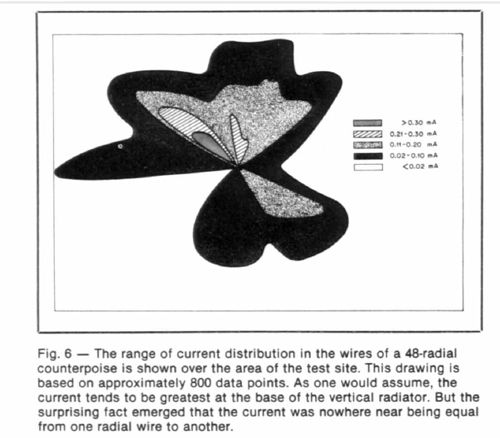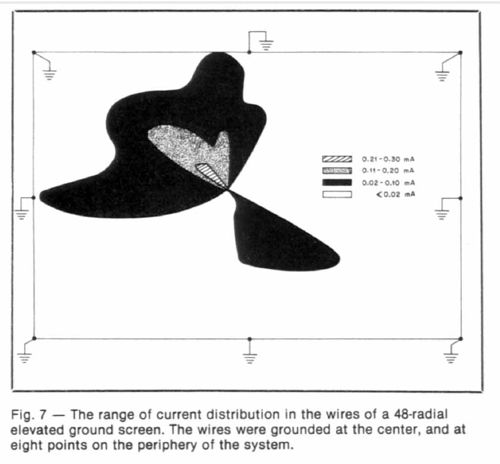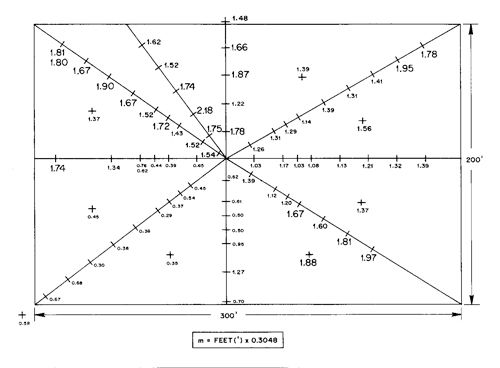I don't have the understanding of capacitance to discuss the issue. I just reported that the guy's doing the 1979 testing in North Carolina discounted the claim, and that prior to that point the science was claiming that the counterpoise worked like a large capacitor.
These guy's report also seemed to draw this conclusion based on the fact that their test results showed the resistance in the Earth around the base of the antenna was not...as evenly distributed (homogeneous) as the prior 60 years of RF science had suggested.
IMO, claims on both sides of the issues above would depend on the facts, so you could be right DB.
What I used to visualize was a large capacitor made up of a screen of wires and the earth below as the plates.
After reading this article I now see the counterpoise doing two separate jobs at the same time. One, they act partly like elevated radials (that is radials above where capacitance of the earth would effect them) and two, I now visualize is each wire, and even different parts of each wire acting as a separate capacitor with the earth below it. Each capacitor is variable and what the variable setting is set to depends on the conductivity of the earth below. All of these are run in parallel, effectively adding up to a single large capacitor.
I would imagine that using this image, the wires (or parts thereof) that are above the more conductive earth would have more of an effect on the radiation pattern of the antenna than the parts of wires that are not.
It is possible that I am wrong here, I am simply using what I know and am applying it to what I have read in this article.
I can't deny that my models show the counterpoise idea producing a little better gain compared to the traditional raised radial setup when both are low and at the same height above Earth. I also think this report also indicated the counterpoise could in some cases produce better results, and they explained why as well.
So, I don't think this report is suggesting the counterpoise is of no benefit, just that some of the ideas on how it worked were surprising and different from what had been indicated over the prior 60 years.
For me, knowing that the counterpoise can work well in some situations is far more important than knowing precisely how it works.
I can both agree and disagree with this statement. That being said I tend to favor learning why something works. To know that something works is one thing, but knowing why and how it works can help you fix it if there are issues, and potentially improve on the design.
I did model my 1/4 wave at 1.85 mhz with 160 radials at 15' above ground, and it too is not able to equal the gain of the same radiator with a rectangle shaped counterpoise at 15' feet above Earth. Too bad Eznec won't let me model radials below the ground.
Something I am not sure about is how well EzNEC reproduces the variance in conductivity this article found in the earth over a relatively small area. I am also curious, if it could make such a distinction, how it may affect the model.
At this point it might be good to know why the counterpoise all but disappeared from discussion and use.
I personally think the original use of the word disappeared because there was a lack of need for it. Look at what has happened with radio over the decades, the useable frequencies got higher and higher, and those used smaller and smaller antennas. Even at HF, we can typically elevate the antennas used fairly easily above where they would have any real capacitance with the earth. Technology itself has moved along with it. Would we have cell phones today if we were limited to HF and lower frequencies?
Revisiting something you said prior to this post.
Cebik did make a claim in conclusion that the term was based on mechanical science, and went on to say there is no scientifically reliable source in RF for the idea as far back as he could source, and the maybe we should just decline using the term...unless a full description of its use is also provided.
As have I...
The definition of the word would be the next factor that I examine. We should decide if this definition is even relevant for Antenna Engineering as it does not fit the historical uses of the term, and originates elsewhere in engineering. In mechanical engineering, where the word originates, the term means to oppose a force with an equal and opposite force. Some sources use the term "balancing" force. Looking up multiple different web sources for the definition I get the impression (and some specifically state) that the force must be perfectly balanced, or exactly equal to the force being opposed.
And from the same post...
I'm not sure about the definition that is often given as it originates in mechanical engineering. Antenna theory is part of electrical engineering. While they are both fields of engineering I am at a state of a tossup of weather the definition should still apply or be dismissed. Most people see the definition being completely contradictory to the traditional use of the term in the antenna engineering field.
One problem is while in mechanical engineering it applies to a force only, here we are giving components the same name. I don't think many who call an elevated radial system for an antenna a counterpoise truly understand the definition of the term as I have heard people say things like "you need a counterpoise to complete the antenna". A counterpoise, by definition, cancels with balance, not completes with balance. Of course, all this is dependent on weather the term and its mechanical engineering definition can truly be considered relevant when dealing with RF, which there is obviously some question about.
In the end, there is only one ground system I am aware of that this definition accurately describes, and that is the traditional definition of the word.
And then there is this observation from that same post...
One observation I have made about all of the uses of the term "counterpoise" is that there is no use of the word that doesn't already have a more accurate and descriptive word/phrase already in use to describe what is being referred to.
As of yet, I not seen anything to call this observation into question.
Wow, now that I read over it that was a long post... Perhaps I should have broken that up some...
The DB




